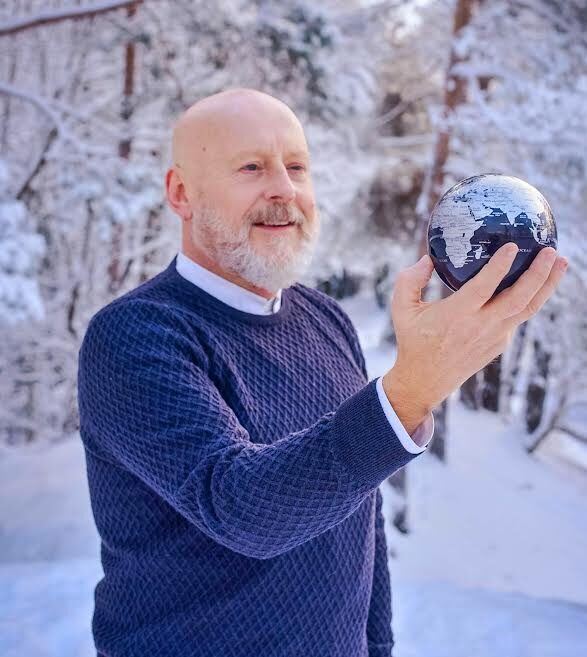Iceland, seven perfect reasons for going there
Seven may be a tiny number because Iceland has so much to offer. However, I have to start somewhere, so here are some suggestions. Earlier I have been writing about turf houses and churches in Iceland. This time I will write more general sights, and later there might be one on hot springs and waterfalls.

Kirkjufell
On my journey on the Circle road in Iceland with a rented sleeper car, I had a long rest at the foot of Kirkjufell “Church Mountain.” I had planned to hike up to the top, only 463 meters above sea level. As you can see, a cloud surrounds the top, which stayed there for the three hours I spent there; because of this, I decided not to climb up. Kirkjufell is claimed to be the most photographed mountain in Iceland. Here I am advertising for my self-made Icelandic sweater.

Grjótagjá
“The Grotto,” on my journey to the north of Iceland, close to Mývatn, I visited this underground hot spring made by a buckle in the earth. The color and atmosphere here are unique, and the greenish-blue water can be tempting to touch, but underneath, it can be scolding, so swimming is forbidden. Grjótagjá is close to The Mývatn Nature Bath; I will write about that in another post. I also read that the cave is not always open for visitors.

The Puffins
The Puffin is Iceland’s most familiar bird, with a population of 8 – 10 million. One can see this decorative bird in many places on the Saga Island. Their main breeding grounds are on sea cliffs and low-lying offshore islands. I wanted to see these birds close up, so I drove out to Borgarfjörður Eystri; here, I got to see a large colony of them. As before, I do not have a camera for close-up animal images, but I hope you still get the feeling of my experience.

Iceland
This was my second trip to Iceland, and during the lockdown for covid 19. Iceland was one of the only countries that were open to tourists. I found that a perfect opportunity to come here for a second time. And renting a sleeper car was brilliant; I could stop wherever I wanted. Even though Iceland has relatively strict laws against not camping outside campsites, I did a couple of times, but rested ashore; I did not litter or leave anything behind.

Diamond Beach
Since Iceland is a large island, it has, of course, many beaches around the shore. Being a volcanic island, most beaches have black sand and rocks. This makes them very different from beaches around the world. Diamond Beach is one beach you pass when you drive the circle road. Here the ice that melted from Jökulsárlón Glacier was washed on shore, contrasting with the black volcanic sand. This beautiful display makes it a favorite location for photographers and nature lovers

Fjaðrárgljúfur Canyon
Iceland has some spectacular canyons; one is Fjaðrárgljúfur canyon in South Iceland. The canyon is up to 100 m deep and 2 km long with quite a unique serpent-like shape; the river Fjaðrá runs through it. The Fjaðrárgljúfur canyon was not well-known to visitors to Iceland until a few years ago. It is not difficult to get there because it is not far away from the main ring road, and the gravel road that leads you up there is in good condition.

Reynisfjara Black Beach
Sneaker waves make Reynisfjara beach one of the most dangerous destinations in Iceland. Reynisfjara is a long beach on the South coast of Iceland, near the town of Vik. It is covered with black volcanic ash and dark rocks, hence the nickname “The black sand beach.” At the end of the beach are the Reynisdrangur, towering fingers of black rock standing out to sea. Behind the beach, there is a mountain with a few caves. What is fascinating is how the stones look like organ pipes in a church. If you go to the Harpa Concert Hall in Reykjavik, you can see the glass-like columns resembling nature.


The Harpa
Harpa Concert Hall was very controversial at the time of its construction. It was only half finished when the financial crash struck, and the financier was bankrupted. However, with a lot of effort by the city and the state, and downscaling the design somewhat, it was finished in 2011. The exterior is a wonder of glass, designed by artist Ólafur Elíasson; it won the Mies van der Rohe Award and the European Union Prize for Contemporary Architecture. We in Norway can see his architectural art in the Lobby of the Opera House, the Glacier walls around the restrooms. Unfortunately, I have only been to Reykjavik in summer, when no performances are happening, but I have seen the red auditorium.

Not to make the posts too long, I try to divide them into themes or subject matters. That is why I still have so many exciting places in Iceland to write about.







